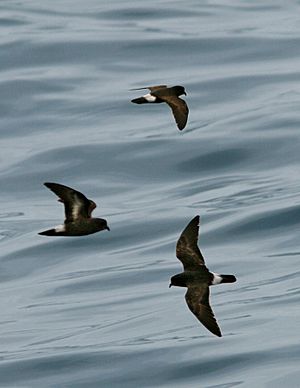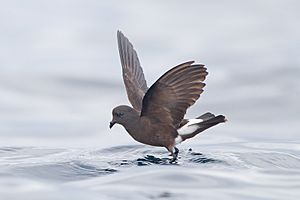Storm petrel facts for kids
Storm petrels are tiny seabirds that spend almost their entire lives flying over the open ocean. They are famous for their unique way of "walking" on the water's surface as they look for food. These amazing birds are part of a larger group of seabirds called Procellariiformes, which also includes albatrosses and shearwaters.


What we call "storm petrels" are actually divided into two main groups, or families, of birds. Even though they look similar and were once thought to be the same family, scientists now know they are different.
Northern Storm Petrels
One group is called the Northern storm petrels, also known as Hydrobatidae. Most of these birds live in the Northern Hemisphere, which is the top half of the Earth. However, some species that live near the Equator might sometimes fly into the southern parts.
There are many different kinds of Northern storm petrels. Some well-known ones include the European storm petrel, Leach's storm petrel, and Fork-tailed storm petrel. They are usually small, dark-colored birds that fly with quick, fluttering wingbeats.
Austral Storm Petrels
The other group is called the Austral storm petrels, or Oceanitidae. These birds are found in all the world's oceans, but they are most common in the Southern Hemisphere. This is the bottom half of the Earth.
Only a few types of Austral storm petrels are seen in the Northern Hemisphere. For example, the White-faced storm petrel breeds in the North Atlantic Ocean, and Wilson's storm petrels travel there during their long migrations. Other types include the Grey-backed storm petrel and the Black-bellied storm petrel. Austral storm petrels often have longer legs and a different flying style compared to their northern relatives.
Life at Sea
Storm petrels are truly ocean birds. They come to land only to breed, usually nesting in burrows or crevices on remote islands. They lay just one egg. After the chicks hatch, both parents take turns flying out to sea to find food, bringing it back to their young.
These birds mostly eat small crustaceans, tiny fish, and squid that they find floating on the ocean surface. They often follow ships, hoping to find food stirred up by the boats. Their ability to "walk" on water helps them pick up these small food items without landing.

